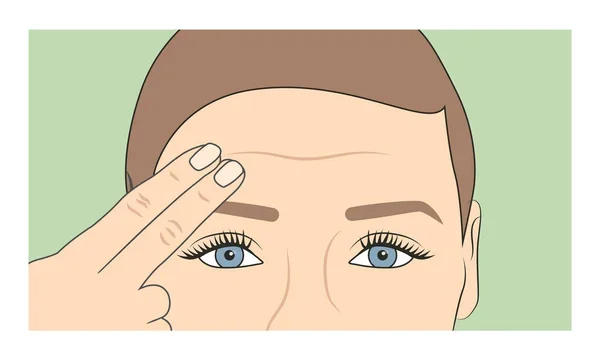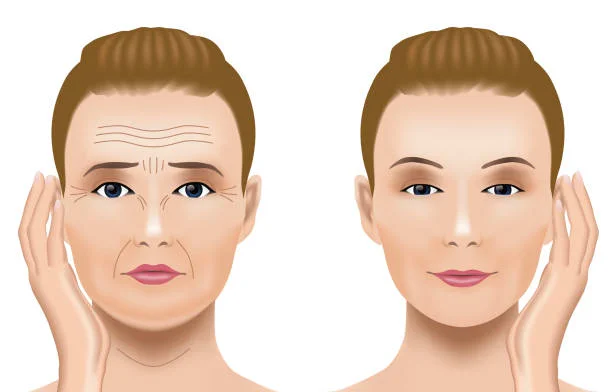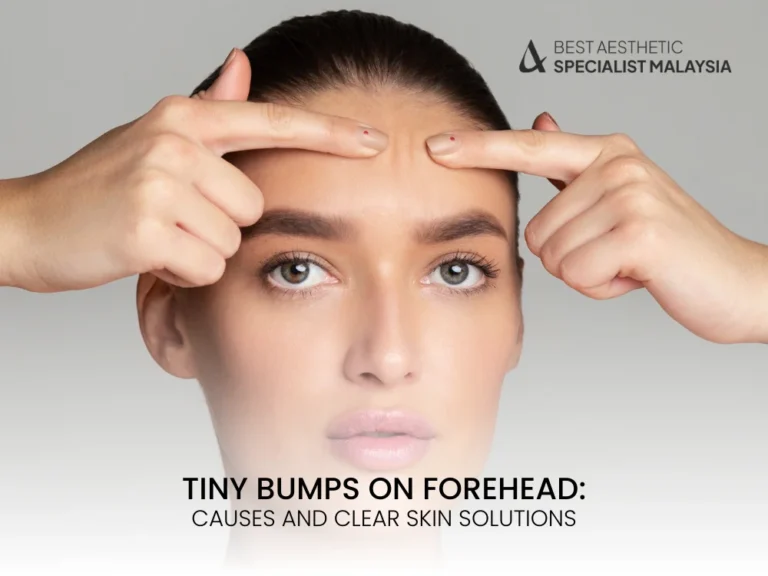If you’ve noticed tiny bumps on forehead that won’t go away, you’re not alone. These small, rough or flesh-colored bumps are a common skin concern for both teens and adults. While they might not be red, painful, or inflamed like traditional acne, they can still affect your confidence and comfort.
The good news? These bumps are usually harmless and treatable. But to smooth them out effectively, it’s crucial to understand what’s causing tiny bumps on forehead and how to manage them with the right skincare habits, lifestyle choices, and treatments.
What Are the Tiny Bumps on Forehead?
Tiny bumps on forehead are a common skin concern, often caused by a buildup of dead skin cells, oil (sebum), sweat, or keratin that blocks pores or hair follicles. Because the forehead sits in the T-zone—the area that naturally produces more oil—it’s more prone to congestion, especially if combined with certain lifestyle, skincare, or environmental factors.
These bumps can take different forms, each with distinct causes:
Closed comedones (whiteheads) – Small, flesh-colored or white bumps formed when pores are clogged with oil and dead skin but remain closed at the surface. They don’t usually hurt but can cluster together and feel bumpy.
Milia – Tiny, hard, pearl-like cysts caused by trapped keratin beneath the skin. They’re not acne and can’t be squeezed out at home without risking damage.
Fungal acne (Malassezia folliculitis) – Itchy, uniform bumps caused by yeast overgrowth in hair follicles. Often mistaken for regular acne, but it doesn’t respond well to standard acne treatments.
Heat rash (miliaria) – Small, red, or clear bumps that appear when sweat ducts become blocked, common in hot, humid weather or after intense workouts.
Sebaceous hyperplasia – Enlarged oil glands that create small, yellowish bumps. They’re harmless but can be persistent.
Why the Forehead Is a Hotspot
The skin on your forehead contains a high density of sebaceous glands, which produce natural oils to protect your skin. However, when these glands become overactive—due to hormones, stress, diet, or skincare products—the excess oil can trap dirt and dead skin cells, creating the perfect environment for bumps to form.
Other contributing factors include:
Hair products transferring oils and silicones to the skin
Wearing hats, helmets, or headbands that trap heat and sweat
Not cleansing properly after sweating or wearing makeup
Hormonal fluctuations that increase sebum production

Common Causes of Tiny Bumps on Forehead
1. Excess Oil Production
Your forehead is part of the oil-rich T-zone. Overactive sebaceous glands can clog pores, especially if dead skin isn’t exfoliated regularly.
2. Poor Skincare Habits
Using products that are too heavy, not removing makeup thoroughly, or skipping exfoliation can lead to buildup. Over-washing or using harsh cleansers can also irritate the skin.
3. Hair Products and Forehead Contact
Oils, pomades, dry shampoos, and other hair styling products can clog pores when they come into contact with the forehead. This is often referred to as pomade acne.
4. Sweat and Friction
Sweat that isn’t cleansed from the skin quickly can mix with bacteria and dead skin cells, leading to bumps. Wearing hats, headbands, or helmets for extended periods can also cause friction-related breakouts.
5. Hormonal Fluctuations
Shifts in hormones—common during puberty, menstruation, or stress—can increase oil production and lead to breakouts on the forehead.
6. Fungal Infections
Unlike bacterial acne, fungal acne (Malassezia folliculitis) is caused by yeast overgrowth. It often appears as uniform, itchy bumps and may require antifungal treatments rather than traditional acne products.
Skincare Routine to Treat Tiny Bumps on Forehead
The right routine can help clear up and prevent these stubborn bumps:
Step 1: Cleanse Gently Twice Daily
Use a mild, non-comedogenic cleanser to remove oil, dirt, and product residue. Avoid harsh scrubs or drying ingredients like high-alcohol toners.
Step 2: Exfoliate 2–3 Times a Week
Use a chemical exfoliant with salicylic acid (BHA) or glycolic acid (AHA). These dissolve dead skin and help unclog pores more effectively than physical scrubs.
Step 3: Apply Targeted Treatments
Try spot treatments or serums containing:
- Niacinamide (anti-inflammatory and oil-regulating)
- Retinoids (promotes cell turnover and prevents clogged pores)
- Benzoyl peroxide (if bacteria is a concern)
For fungal acne, look for ingredients like ketoconazole or zinc pyrithione.
Step 4: Moisturize
Even oily skin needs hydration. Use a lightweight, gel-based moisturizer that won’t clog pores.
Step 5: Protect with SPF
Daily sunscreen is essential to prevent irritation and dark spots. Use a non-comedogenic, oil-free formula.

Lifestyle Tips for Preventing Forehead Bumps
Keeping your forehead clear isn’t just about what you put on your skin—it’s also about the daily habits you build. Here are practical lifestyle tips to help prevent bumps before they start:
Change pillowcases frequently – Oils, sweat, and bacteria accumulate on pillowcases faster than you think. Aim to change them at least twice a week to minimize skin contact with pore-clogging buildup.
Keep hair off your forehead – Hair products like gels, serums, and hairsprays can transfer to your skin and clog pores. If you use styling products, try tying your hair back or using headbands to keep it away from your face.
Avoid touching your face – Your hands carry dirt, oil, and bacteria from everything you touch. Resist the urge to rest your chin on your hands or brush your bangs aside constantly.
Clean hats, helmets, and headbands regularly – These accessories often trap sweat and oils against your skin, creating the perfect breeding ground for breakouts. Wash or disinfect them weekly.
Maintain a balanced diet – Processed foods, excessive sugar, and dairy may trigger skin issues in some people. Incorporate fresh fruits, vegetables, and omega-3-rich foods to support skin health from within.
Stay hydrated – Drinking enough water helps regulate oil production and supports your skin’s natural barrier. Aim for at least 8 glasses a day, more if you’re active.
Manage stress – High stress levels can spike cortisol, leading to excess oil production and inflammation. Try activities like yoga, meditation, or even short daily walks to keep stress in check.
When to See a Dermatologist
Most forehead bumps are harmless and respond well to consistent home care, but sometimes professional help is the best next step. Consider booking an appointment if your bumps:
Persist for several weeks despite consistent skincare and lifestyle adjustments
Become itchy, painful, or inflamed
Look like they might be fungal acne, milia, or another non-standard skin condition
Start leaving dark spots, discoloration, or scarring behind
A dermatologist can examine your skin closely and create a customized treatment plan. This may include prescription-strength creams, targeted antibiotics, chemical peels, or professional extractions. Early intervention can prevent long-term damage and restore your skin’s smooth texture faster.
Tiny Bumps on Forehead vs. Acne: What’s the Difference?
While both can appear similar, they’re not always the same:
Type | Description | Common Causes |
Closed comedones | Flesh-colored bumps under the skin | Oil, dead skin, clogged pores |
Fungal acne | Uniform itchy bumps, no pus | Yeast overgrowth |
Milia | Small white cysts, not red or inflamed | Trapped keratin, often chronic |
Heat rash | Small red bumps, often itchy | Sweat trapped under the skin |
Knowing the difference can help you choose the right products and avoid worsening the issue.
FAQs
1. Are the tiny bumps on forehead acne?
They could be, but not always. Tiny bumps forehead may also be fungal acne, milia, or heat rash. Each has different causes and treatments.
2. Can diet cause bumps on the forehead?
Yes. High sugar intake, dairy, and greasy foods can trigger oil production or hormonal changes that lead to breakouts.
3. What ingredients should I avoid?
Avoid heavy oils, comedogenic ingredients like coconut oil, and alcohol-based products that can irritate or dry out the skin.
4. How long does it take to clear forehead bumps?
With a consistent skincare routine, many people see improvement within 4–6 weeks. More stubborn cases may take longer or need professional care.
5. Can exfoliation make forehead bumps worse?
Yes, if overdone. Over-exfoliating can damage the skin barrier and lead to more irritation. Stick to 2–3 times a week with gentle acids.
6. Can stress cause forehead bumps?
Yes. Stress can increase cortisol levels, which may trigger oil production and lead to clogged pores or inflammation.
7. Are forehead bumps contagious?
Most aren’t, but fungal acne can spread through shared items like towels or pillowcases. Always maintain good hygiene.
8. Can makeup cause forehead bumps?
Yes. Heavy or non-comedogenic makeup can clog pores, especially if not removed properly before bed.
9. Should I pop the bumps on my forehead?
No. Picking or popping can worsen inflammation, cause scarring, and spread bacteria.
10. Can sleeping habits affect forehead bumps?
Yes. Dirty pillowcases, sleeping with hair products near the forehead, or sleeping on your stomach can transfer oils and bacteria to the skin.
11. Is it normal for tiny bumps on forehead to itch?
Mild itchiness can happen, especially with fungal acne or allergic reactions. Persistent itching should be checked by a dermatologist.
12. Do tiny bumps on forehead go away on their own?
Some do, especially if caused by temporary irritation or sweat. Others need targeted skincare or medical treatment to fully resolve.
Final Thoughts on Tiny Bumps on Forehead
Tiny bumps on forehead may be common, but they’re not inevitable. With the right care, you can calm your skin, clear congestion, and prevent future breakouts. Be patient, consistent, and mindful of your skincare and lifestyle habits.
And remember—smooth skin is more about health than perfection. Every step you take toward understanding your skin brings you closer to lasting clarity and confidence.
